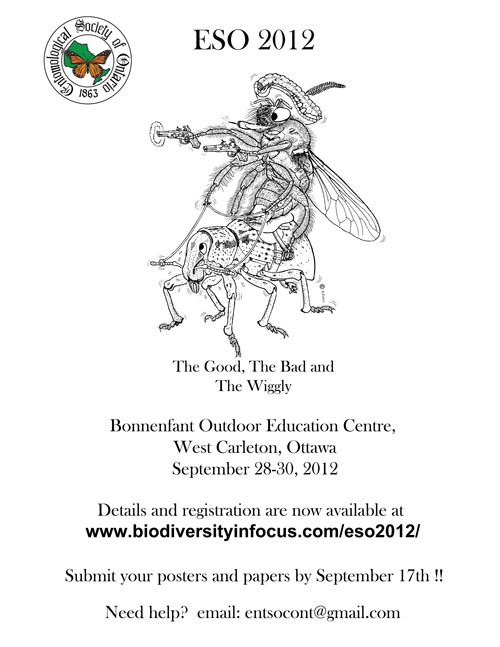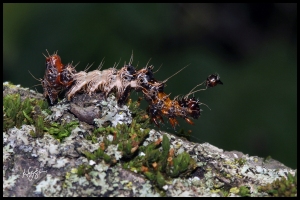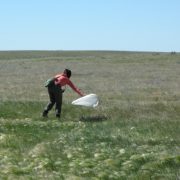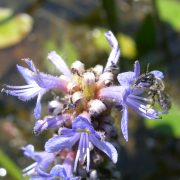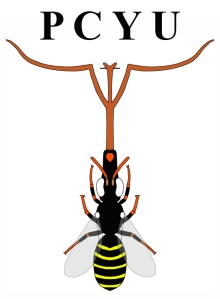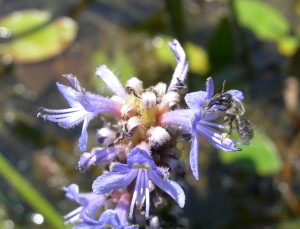Many of us appreciate insects, spiders and other arthropods for more than just their scientific, biological or ecological value: they also have an aesthetic that some of us find irresistible, inspiring us to capture them in photographs or in paintings rather than sweep nets or aspirators.
For this special feature, we interviewed Elizabeth Goluch, a Halifax artist, and asked her about her breathtaking insect sculptures.

PRAYING MANTIS
Sterling silver, copper, 14K & 18K gold
18.5″l x 12″w x 9.5″h
ESCBlog: Please tell us a little bit about your background – where you grew up, when you started doing art, where you did your formal training.
EG: I grew up on a farm in southwestern Ontario. I have been making drawings and objects for as long as I can remember.
I took summer drawing classes at the University of Western Ontario, after which I acquired my BFA in 1976 at the Nova Scotia College of Art & Design. However, my major was in Painting. Much later, around 1997, I learned to solder by taking continuing education classes at NSCAD. I also became a member of the Metal Arts Guild of Nova Scotia which is a Guild in the traditional sense. If you wish to learn a certain skill, you have only to ask and another member will provide the help that you need. Over time, I enrolled in several summer sessions at Haystack Mountain School of Craft thereby acquiring additional metalsmithing skills. So I would have to say that I have had little formal training in working with metal and am, for the most part, self-taught.
ESCBlog: Why insects? Have you always been interested in insects as subjects for your art?
EG: Insects have always attracted me. As a child I collected and examined dead insects, seeing them as objects of beauty. An early memory is one of drawing page after page of spiders which gave me a great sense of satisfaction.

TARANTULA
Sterling silver, 14k & 18k gold, tourmaline
7.25″l x 8″w x 2.25″h
ESCBlog: Most of your sculptures have movable parts; many contain hidden trinkets that can be removed and even worn as jewellery. Tell us about this choice to include interactive components.
EG: When I first began to make metal insect sculptures, I concentrated on the insect form. Over time, I realized that I wanted to add another dimension to each sculpture which resulted in the secret compartments containing hidden treasure.

ESCBlog: Although your pieces are incredibly lifelike, they also include many whimsical elements (a children’s poem enacted in a lady beetle) and often embrace word-play (e.g., the violin beetle). Tell us about your choice to blend the realistic with the fantastical.
EG: As my work has grown I have come to realize that, as much as I enjoy accuracy in building the body parts of each insect, I am also interested in telling the story of the insect. This is accomplished by including information about the insect’s life, lore and environment in the decorative details and secret spaces, increasingly important elements of each work.
ESCBlog: Insects are so often portrayed as something dark and sinister – something to fear. Your work, however turns insects and spiders into precious things made of gold, silver, pearls and gemstones. Can you talk a bit about your choice of materials in your pieces?
EG: Conversely, I have always seen insects as living jewels. However, I enjoy the combination of fear and attraction engendered in the viewer by the juxtaposition of the subject matter (insects) and the richness of the materials used (gold, silver, gemstones) in the making of the object.
ESCBlog: You’ve tackled many different types of insects, and even arachnids, in your work. Is there anything you haven’t attempted to sculpt yet that you’d like to?
EG: There are so many insects in the world that I can’t imagine ever running out of options for the next piece.
(However, I must confess that after repeated requests, I recently completed a commission that was not an insect. I made a Snail which turned out to be one of the most complex pieces that I have made to date. It will appear on my website in the near future.)
ESCBlog: Do you have a favorite piece? If so, why is it your favorite?
EG: I can’t say that I have one favourite piece. What I will say is that I enjoy the increasing complexity of story and detail incorporated in each new piece.

LADYBUG
sterling silver, 18k gold, garnets, enamel, ceramit
4.75″l x 3.75″w x 2″h
ESCBlog: Can people purchase the work your have shown on your website? Do you ever do commissioned pieces?
EG: Much of the work on my website has been sold or was a commissioned piece. I have, on occasion, made a second or third version of one insect (Dragonfly, LadyBug). However, no two pieces are ever the same, each differing in size, details and story.
ESCBlog: Is there anything else we should know about you or your work?
EG: I have won numerous awards including Finalist for the Lieutenant Governor of Nova Scotia Masterworks Arts Award, the Frank Phillips Award for Excellence in Craftsmanship, Best in Show in many Metal Arts Guild of Nova Scotia Competitions/Exhibitions, grants from the Nova Scotia Department of Tourism, Culture and Heritage, and from the Canada Council for the Arts.
My work has been exhibited internationally, including the 2009 Cheongju International Craft Biennale in South Korea where Canada was invited as the guest country, the Cultural Olympiad in the Museum of Vancouver BC to coincide with the 2010 Olympics, Cesky Krumlov in the Wenceslas Cellars of the State Castle of the Czech Republic, SOFA New York and the Mary E. Black Gallery in Halifax NS. One of my works was included in the Metal Arts Guild of Canada Exhibition in Print 2011 curated by Gloria Hickey.
My sculptures can be found in public and private collections in Canada, the USA, Denmark, Australia, Turkey and Hong Kong.
I have given lectures in Halifax at the Joint Annual General Meeting of the Canadian Entomological Society & the Acadian Entomological Society and at NSCAD, in South Korea at the 2009 Cheongju International Biennale, in New York at SOFA, and in Cornwall ON as the keynote speaker at the Artpreneur Conference.
I sit on the Exhibition Review Committee of the Mary E. Black Gallery Halifax NS and on the Standards Committee of the Nova Scotia Designer Crafts Council.
ESCBlog: Where can we go to see some of your work?
EG: My work will be included in upcoming exhibitions at the Mary E. Black Gallery Halifax NS and at The Rooms Provincial Gallery in St. John’s NL, both of which will subsequently travel across Canada.
I am in the Studio Rally Map and will participate in the upcoming Studio Rally Weekend.
Dates: Saturday September 29th and Sunday September 30th
Hours: 10:00 am to 5:00 pm – by chance or appointment
more info: www.StudioRally.ca

BUMBLEBEE
Sterling silver, 14K & 18K gold
7″l x 7″w x 4″h
If you’d like to reach Elizabeth, here is her contact information:
Website: www.elizabethgoluch.com
email: e@elizabethgoluch.com
Representation: Mobilia Gallery,Cambridge/Boston MA.
Availability in Halifax: my Studio – 6913 Tupper Grove, Halifax, NS.
Visitors & commissions welcome.
__________________________________________
Do you know any other incredible Canadian artists who feature insects in their work? We’d love to hear about it?














